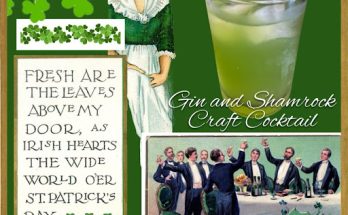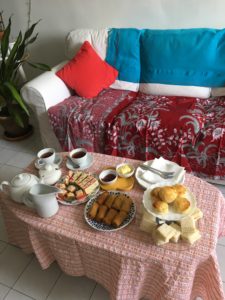

By Sharmini Jayawardena
It’s the last word in elegance. It’s a delightful gathering of friends in conversation. It’s time to have Afternoon Tea, in your garden, weather permitting, or in your Drawing Room. The room which you “withdraw” to.
The set time for Afternoon Tea is 4pm. It may go on for an hour or two or more.
You are Invited –
Here’s an invitation I created for a themed tea party. In this case an 






On the way to the venue were placed props, hinting as to the theme of the party, a broken down clock and an enlarged playing card. The venue was decorated with a bunny and Easter egg related tablescape and balloons 

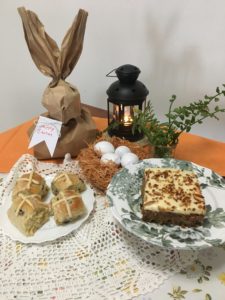
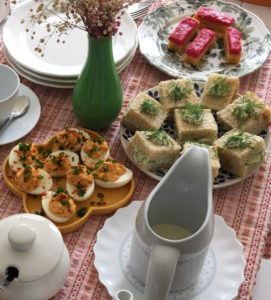
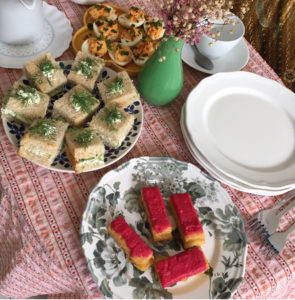
Each of the guests assumed a prominent bunny name of their choice or one assigned to them by the hostess. In this case, the names were, Easter Bunny 

A piece of poetry or passage of their choice identifying with the assumed bunny names was read out by each persona.
The party highlight was the egg hunt
***************
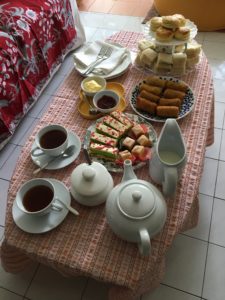
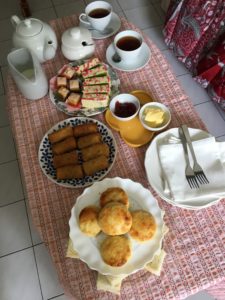
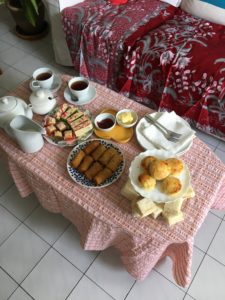
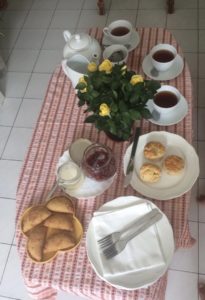
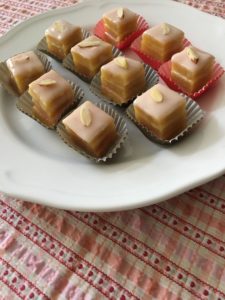
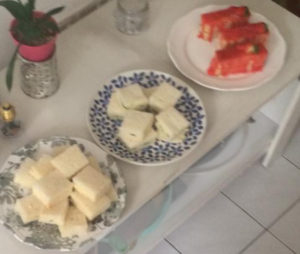
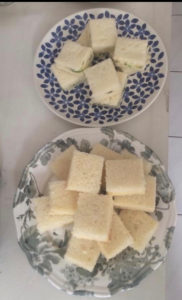
The history of Afternoon Tea dates back to the 19th Century. Anna, the 7th Duchess 
Lo and behold, hence, Afternoon Tea came to be! You will find below, an article, discussing nearly everything you need to know about the wonderfully elegant pursuit of having Afternoon Tea and all about Afternoon Tea etiquette, that makes it all the more pleasurable.
Here’s the complete guide to serving afternoon tea, if you will.
Let me share with you, some of the etiquette that comes to mind which needs to be observed while having Afternoon Tea.
Let us start with the most important element in the whole pleasurable exercise, which is, preparing the tea. This being essentially an Englishman’s indulgence, tea here refers to loose black tea leaves 
The pure black tea leaves are Orange Pekoe, Gold Tip and Silver Tip being the top white teas. Ceylon tea being the top notch tea leaves to look for. The British originally introduced the habit of drinking tea to the modern world, from tea grown in the highland tea gardens of Ceylon and Darjeeling, India. Only the two leaves and a bud leaf are hand picked , from a tea bush, in the process of plucking tea leaves for processing, in the making of these superior brews.
http://teasrilanka.org/tea-grade
Today, however, other types of tea like green tea, other floral teas, and even Champagne have been introduced to the menu.
Afternoon tea is a British aristocratic pursuit, and is referred to as low tea as the tea was served at a low table where friends gathered around to converse.
High tea on the other hand was had on a high table with leftovers, by the servants, after the ladies and gentlemen had concluded having their Afternoon Tea. The term Afternoon Tea has been misconstrued by many a hotel which offer Afternoon Tea calling it High Tea!
To brew the tea leaves here’s what you must follow:
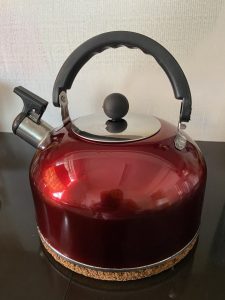

Boil fresh water on an open flame in a teakettle or a whistling kettle which is more British, as the guests arrive. (Some even choose the type of water to be used such as soft water, and not hard water. You can achieve this by straining the water). When there’s a good amount of smoke coming out of the spout, you open the lid of the tea pot, and pour some water from the kettle into the pot. You then twirl it around and pour that water out. This is all done to ensure that the pot is kept hot in the entire process of brewing the tea. Always keep the pot next to the boiling teakettle.

You add one teaspoon of tea leaves for the pot and one each for each of the cups and more if you want to enjoy more tea. It is best to start the process all over again for the next round of tea.

Open the lid of the teapot, which is now placed next to the teakettle. Pour the boiling water into the pot to measure up to the number of cups to be brewed. (It is best to gauge the number of cups the pot can hold, by measuring it with cups of cold water, prior to the process of steeping the tea). Cover the pot with the lid. Place the tea cozy on the pot. Keep for five minutes.

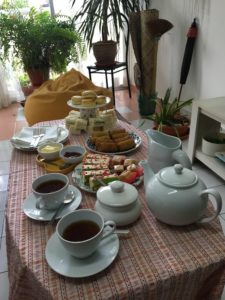
Place the tea strainer on the tea cup. Pour the tea from the pot into the tea cups from slightly above the cup through the tea strainer into the cup. Do the same when pouring into each cup.
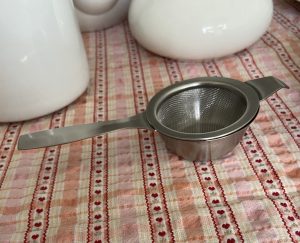

Observing etiquette in making tea involves pouring the tea into the cup first and then adding milk and sugar. (It is said that those partaking of High Tea, did not have fine china. So, in order to save the cups or mugs from cracking under high temperature, they added the milk to the cup first).
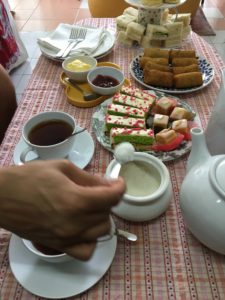
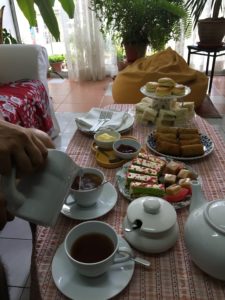
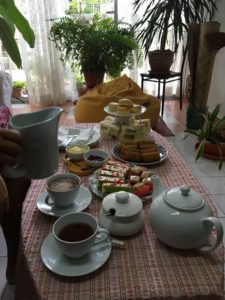

Once the milk and sugar is added, you stir the tea with the teaspoon, which must at all times be placed on the upper right hand side of the saucer, in an upward and downward motion. Some stir the tea anti-clockwise. This is supposed to stop spillage.
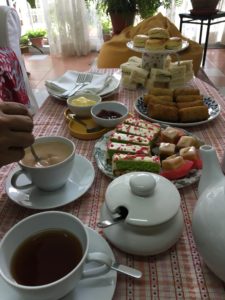

Once the tea is stirred, you sip the tea and not slurp it, by holding the tea cup in your right hand by the handle. Never pass your fingers through the handle. And, never hold your little finger or pinky out! Have the saucer under the tea cup in your left hand at all times while sipping your tea.
These are the most important etiquette to be observed when having tea in this most elegant affair called Afternoon Tea.
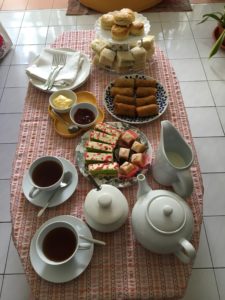
I put together this tea set with pieces gathered from different places. My Creamer is a conversation piece by itself 


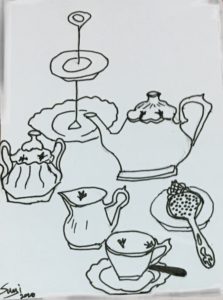
The low table is laid with a table cloth*. On which are placed (Top) the tiered tray, (L) sugar bowl, (R) tea pot, (Center) creamer, tea strainer with saucer, (Bottom) tea cup and saucer with teaspoon, individual tea plates and napkins (not in the picture) which are smaller than those used at a main meal.
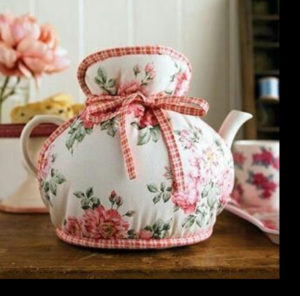
Keep the pot warm with a Tea Cosy.
Now, for the little delectables that go together with sipping tea in the afternoon.
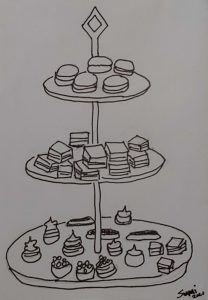
The three tiered cake tray

It is an absolute no no to serve cupcakes 



The sandwiches and savouries are to be had first, followed by scones and sweets.
It’s strictly a finger affair 

Here’s a Menu I created for an Afternoon Tea party with a friend.
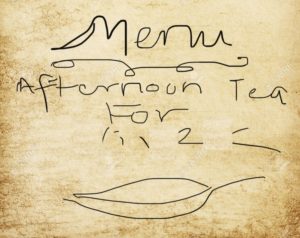
On the Menu are –
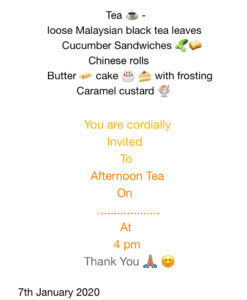
Recipes for each of these finger foods, all delightfully prepared in the Leaf 




Lets enjoy a tea soiree journaling experience.
*The table is laid with a seersucker table cloth. The fabric was brought to America by way of England which found it trading in India with the British East India Company in the 1600s. It was called shirushakar there or shir O shakka, Persian for “milk and sugar”, according to the Encyclopedia of Textiles. How very convenient for me 
Stuffed Chilies or Capsicums/Maalu Miris*/Charleston Peppers
Illustrations by Sumiitra Sooriaarratchi
![]()
(adsbygoogle = window.adsbygoogle || []).push({});
(adsbygoogle = window.adsbygoogle || []).push({});



 Fish Patties
Fish Patties
